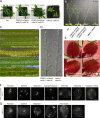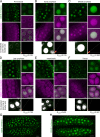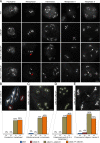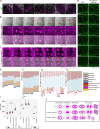CDKD-dependent activation of CDKA;1 controls microtubule dynamics and cytokinesis during meiosis
- PMID: 32609301
- PMCID: PMC7401817
- DOI: 10.1083/jcb.201907016
CDKD-dependent activation of CDKA;1 controls microtubule dynamics and cytokinesis during meiosis
Abstract
Precise control of cytoskeleton dynamics and its tight coordination with chromosomal events are key to cell division. This is exemplified by formation of the spindle and execution of cytokinesis after nuclear division. Here, we reveal that the central cell cycle regulator CYCLIN DEPENDENT KINASE A;1 (CDKA;1), the Arabidopsis homologue of Cdk1 and Cdk2, partially in conjunction with CYCLIN B3;1 (CYCB3;1), is a key regulator of the microtubule cytoskeleton in meiosis. For full CDKA;1 activity, the function of three redundantly acting CDK-activating kinases (CAKs), CDKD;1, CDKD;2, and CDKD;3, is necessary. Progressive loss of these genes in combination with a weak loss-of-function mutant in CDKA;1 allowed a fine-grained dissection of the requirement of cell-cycle kinase activity for meiosis. Notably, a moderate reduction of CDKA;1 activity converts the simultaneous cytokinesis in Arabidopsis, i.e., one cytokinesis separating all four meiotic products concurrently into two successive cytokineses with cell wall formation after the first and second meiotic division, as found in many monocotyledonous species.
© 2020 Sofroni et al.
Figures














Similar articles
-
Cyclin-dependent kinase-activating kinases CDKD;1 and CDKD;3 are essential for preserving mitotic activity in Arabidopsis thaliana.Plant J. 2015 Jun;82(6):1004-1017. doi: 10.1111/tpj.12872. Epub 2015 May 25. Plant J. 2015. PMID: 25942995
-
The Arabidopsis cyclin-dependent kinase-activating kinase CDKF;1 is a major regulator of cell proliferation and cell expansion but is dispensable for CDKA activation.Plant J. 2009 Aug;59(3):475-87. doi: 10.1111/j.1365-313X.2009.03884.x. Epub 2009 Apr 2. Plant J. 2009. PMID: 19368694
-
A complex role of Arabidopsis CDKD;3 in meiotic progression and cytokinesis.Plant Direct. 2023 Mar 6;7(3):e477. doi: 10.1002/pld3.477. eCollection 2023 Mar. Plant Direct. 2023. PMID: 36891158 Free PMC article.
-
Regulation of organization and function of microtubules by the mitogen-activated protein kinase cascade during plant cytokinesis.Cytoskeleton (Hoboken). 2012 Nov;69(11):913-8. doi: 10.1002/cm.21072. Epub 2012 Oct 1. Cytoskeleton (Hoboken). 2012. PMID: 23027702 Review.
-
Control of cell division and transcription by cyclin-dependent kinase-activating kinases in plants.Plant Cell Physiol. 2005 Sep;46(9):1437-42. doi: 10.1093/pcp/pci170. Epub 2005 Jul 15. Plant Cell Physiol. 2005. PMID: 16024551 Review.
Cited by
-
ASPM Induces Radiotherapy Resistance by Disrupting Microtubule Stability Leading to Chromosome Malsegregation in Non-Small Cell Lung Cancer.Exploration (Beijing). 2025 May 7;5(4):e20230024. doi: 10.1002/EXP.20230024. eCollection 2025 Aug. Exploration (Beijing). 2025. PMID: 40873651 Free PMC article.
-
Live Cell Imaging of Male Meiosis in Arabidopsis by a Landmark-based System.Bio Protoc. 2020 May 5;10(9):e3611. doi: 10.21769/BioProtoc.3611. eCollection 2020 May 5. Bio Protoc. 2020. PMID: 33659575 Free PMC article.
-
B1-type cyclins control microtubule organization during cell division in Arabidopsis.EMBO Rep. 2022 Jan 5;23(1):e53995. doi: 10.15252/embr.202153995. Epub 2021 Dec 9. EMBO Rep. 2022. PMID: 34882930 Free PMC article.
-
A CENH3 mutation promotes meiotic exit and restores fertility in SMG7-deficient Arabidopsis.PLoS Genet. 2021 Sep 30;17(9):e1009779. doi: 10.1371/journal.pgen.1009779. eCollection 2021 Sep. PLoS Genet. 2021. PMID: 34591845 Free PMC article.
-
Jasmonates, gibberellins, and powdery mildew modify cell cycle progression and evoke differential spatiotemporal responses along the barley leaf.J Exp Bot. 2024 Jan 1;75(1):180-203. doi: 10.1093/jxb/erad331. J Exp Bot. 2024. PMID: 37611210 Free PMC article.
References
Publication types
MeSH terms
Substances
LinkOut - more resources
Full Text Sources
Molecular Biology Databases
Miscellaneous

